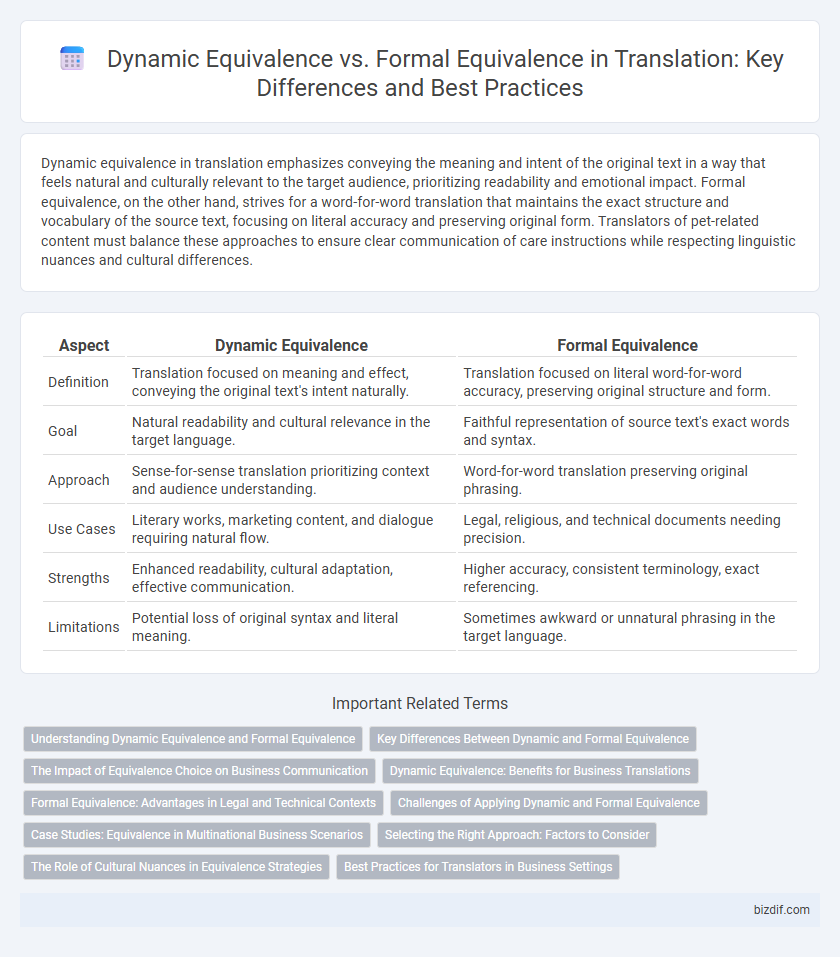Dynamic equivalence in translation emphasizes conveying the meaning and intent of the original text in a way that feels natural and culturally relevant to the target audience, prioritizing readability and emotional impact. Formal equivalence, on the other hand, strives for a word-for-word translation that maintains the exact structure and vocabulary of the source text, focusing on literal accuracy and preserving original form. Translators of pet-related content must balance these approaches to ensure clear communication of care instructions while respecting linguistic nuances and cultural differences.
Table of Comparison
| Aspect | Dynamic Equivalence | Formal Equivalence |
|---|---|---|
| Definition | Translation focused on meaning and effect, conveying the original text's intent naturally. | Translation focused on literal word-for-word accuracy, preserving original structure and form. |
| Goal | Natural readability and cultural relevance in the target language. | Faithful representation of source text's exact words and syntax. |
| Approach | Sense-for-sense translation prioritizing context and audience understanding. | Word-for-word translation preserving original phrasing. |
| Use Cases | Literary works, marketing content, and dialogue requiring natural flow. | Legal, religious, and technical documents needing precision. |
| Strengths | Enhanced readability, cultural adaptation, effective communication. | Higher accuracy, consistent terminology, exact referencing. |
| Limitations | Potential loss of original syntax and literal meaning. | Sometimes awkward or unnatural phrasing in the target language. |
Understanding Dynamic Equivalence and Formal Equivalence
Dynamic equivalence in translation prioritizes conveying the original text's intended meaning and emotional impact, ensuring the translation resonates naturally with the target audience. Formal equivalence strictly adheres to the source text's structure and vocabulary, preserving grammatical forms and exact wording to maintain fidelity. Understanding the distinction between dynamic and formal equivalence is crucial for selecting the appropriate translation approach based on the text's purpose and audience.
Key Differences Between Dynamic and Formal Equivalence
Dynamic equivalence prioritizes conveying the intended meaning and emotional impact of the source text, often adapting phrases to sound natural in the target language. Formal equivalence maintains a word-for-word translation approach, preserving the original structure and vocabulary as closely as possible. These key differences influence translation choices based on whether the focus is on literal accuracy or cultural and contextual relevance.
The Impact of Equivalence Choice on Business Communication
Choosing dynamic equivalence in business translation enhances message clarity by prioritizing meaning and cultural relevance, ensuring effective communication across diverse markets. Formal equivalence maintains the original text's structure and terminology, which is crucial for legal contracts and technical documents requiring precision. The choice between these approaches directly affects negotiation outcomes, brand perception, and the accuracy of contractual obligations in multinational business environments.
Dynamic Equivalence: Benefits for Business Translations
Dynamic equivalence in business translations enhances message clarity by prioritizing meaning and cultural context over literal word-for-word rendering, resulting in communications that resonate effectively with target audiences. This approach improves customer engagement and brand perception by adapting content to local linguistic nuances, idiomatic expressions, and cultural expectations. Dynamic equivalence reduces the risk of misinterpretation and increases the impact of marketing materials, legal documents, and technical content in global markets.
Formal Equivalence: Advantages in Legal and Technical Contexts
Formal Equivalence translation preserves the original text's structure and precise terminology, ensuring legal and technical documents maintain their exact meaning and clarity. This approach minimizes ambiguity and upholds the integrity of specialized language critical for contracts, regulations, and technical manuals. By prioritizing literal accuracy, formal equivalence supports consistency and reliability essential in professional fields requiring exact interpretation.
Challenges of Applying Dynamic and Formal Equivalence
Challenges of applying dynamic equivalence include preserving the original text's meaning while adapting cultural nuances to ensure target audience comprehension, often risking oversimplification or loss of subtlety. Formal equivalence faces difficulties in maintaining the precise grammatical structure and lexical form of the source language, which can result in awkward or unnatural phrasing in the target language. Translators must balance fidelity and readability, navigating linguistic and cultural disparities inherent in both methods.
Case Studies: Equivalence in Multinational Business Scenarios
Case studies in multinational business translations highlight dynamic equivalence as crucial for conveying cultural nuances and intent, ensuring target audiences receive contextually appropriate messages. Formal equivalence preserves source text structure and terminology for legal or technical documents, maintaining precision across languages. Effective business communication balances these methods to avoid misinterpretations and foster global collaboration.
Selecting the Right Approach: Factors to Consider
Selecting the right translation approach requires evaluating the purpose of the text, target audience, and cultural context to determine whether dynamic equivalence or formal equivalence is more suitable. Dynamic equivalence prioritizes conveying the intended meaning and naturalness in the target language, ideal for literary or conversational content, while formal equivalence emphasizes literal accuracy and structural similarity, preferred for legal or technical documents. Considering these factors ensures the translation maintains both accuracy and readability, enhancing effective communication.
The Role of Cultural Nuances in Equivalence Strategies
Dynamic equivalence prioritizes conveying the intended meaning and cultural context of the source text, ensuring the target audience comprehends the message naturally and accurately. Formal equivalence emphasizes a word-for-word translation, preserving the original text's structure and literal meaning but often sacrificing cultural nuance and readability. Understanding cultural nuances in translation strategies is crucial for maintaining the effectiveness and relevance of the message across different linguistic and cultural contexts.
Best Practices for Translators in Business Settings
Translators in business settings should prioritize dynamic equivalence to ensure communication is culturally relevant and easily understood by target audiences, enhancing engagement and clarity. Formal equivalence remains essential when preserving precise legal or technical terminology to maintain accuracy and compliance. Balancing both methods by using dynamic equivalence for marketing content and formal equivalence for contracts optimizes effectiveness and reduces misinterpretation risks in global business communications.
Dynamic Equivalence vs Formal Equivalence Infographic

 bizdif.com
bizdif.com